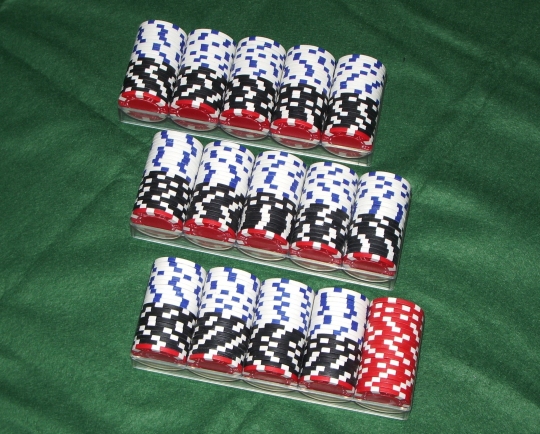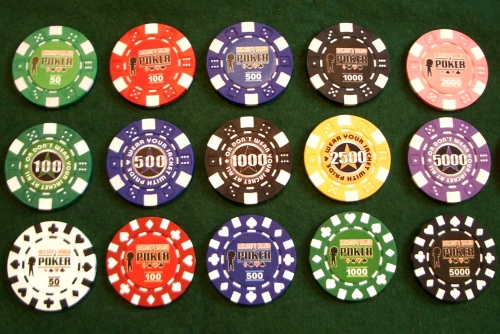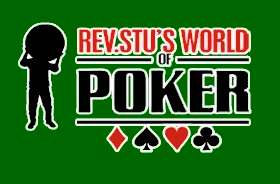|
HOUSE RULES
with The Reverend Stuart Campbell
So
after last month's column you’ve managed to host your first poker game
without it ending in an excessive number of stabbings, and you want
to take the next step. The single biggest leap you can take towards
making a home game feel more like a casino is to buy some proper
chips, which is a more complicated business than you’d think.
The
first thing to decide is what sort of chips to get, and there are
plenty of pitfalls here. Poker exploded in mainstream popularity
last year, to the degree that poker chip sets started popping up
everywhere, even in supermarkets and bargain shops. Lots of these
are cheap plastic rubbish, though, which feel more like tiddlywinks
than casino chips, and the easiest way to tell is to check the
weight.
Anything below 11 grams a chip is likely a piece of kiddy tat, and
most decent chips will actually tell you their weight on the
packaging, so if it isn’t mentioned then beware. (You can get chips
at 15g and even beyond if you pay a lot of money for them, but 11g
is plenty heavy for most casinos and it should be good enough for
you.)
Once
you’ve found quality chips, the next decision to make is how many
you want. The most common count for a proper cased set is 500 chips,
but for a single-table game that’s likely to be far more than you
actually need. (Many cheaper 500 sets also come as 100 chips each of
five different colours, which is a wasteful and impractical
distribution, so avoid those - ideally look for sellers who’ll let you
make up your own combination, usually in multiples of 25.)
The
number and makeup of your chips varies depending on whether you’re
going to be playing tournament or ring games, but either way a 300
set should be plenty for up to 10-12 players.

This is a good 300-chip setup for a fairly
serious ring game of up to 10 players. The chips
are arranged in
handy £10/20 buy-in units, with extra red £10 chips to help keep
things
tidy. At 10p/£1/£10 there’s £480 of chips in this shot.
If
you’re playing cash, three or four different colours of chip is
probably plenty. For example, at our cash games a standard buy-in is
£20, made up of 10 x 10p chips, 9 x £1 and 1 x £10. This gives you
plenty of scope for pots of all sizes, and as a bonus makes the
standard stack 20 chips, which is ideal as it’s the capacity of a
single slot in a normal chip tray. (It also makes it easy for
someone to buy-in for £10 instead of £20 by removing just one chip.)
Depending on your stakes, of course, you can substitute the values
or amounts for whatever suits you – for a cheaper ring game, 8 x
10p, 6 x 20p and 6 x 50p would give you a £5 buy-in unit, also
comprising a convenient 20 chips.
(If you’re playing
such low buy-ins, by the way, blinds of 10p/10p are probably a good
idea.)
For
tournaments, though, you want at least four colours and preferably
five or six, for chip values of 25 (optional), 50, 100, 500, 1000
and 5000 (optional). Including the 25 value gives you scope for two
extra early blind levels if you want a slower-structured game, but
remember that you don’t want the last two or three players to be
gazing at each other from behind massive walls of low-value chips,
so you’ll need some spare big chips to swap them for in the
later stages. (Or "chipping up", as it's properly known.) See “HOW MUCH AND HOW MANY?” for some suggested
combinations.
Obviously the more chips you have the easier things are to organise,
but a 300-chip set gives you a lot of flexibility at the least
expense – you should be able to pick one of those up on eBay or
Amazon for around £15-20 including delivery, with decent-quality
chips, a nice aluminium case and a couple of decks of cards.
Next month: throwing those cards away and choosing some better
ones.
|
CHIPS WITH
EVERYTHING
|
|
THE
WRONG NUMBERS
Something else to watch out for when you’re
buying chips is to make sure you don’t get numbered ones. A
lot of proper casino-weight chips (not the cheapo plastic
ones, for some reason) are sold pre-printed with the
incomprehensible US numbering system, where the chips have
marked values of 1, 5, 25, 50 and 100. I’ve never been able to
figure out the logic of this one - in particular the absence
of a “10” chip - or what freakish kind of a structure you’re
supposed to use such values in. (At first I thought it was
designed to mimic American coin values, but of course
Americans do have a 10-cent piece.)
US-numbered chips are all but useless in
ring games (if you’re betting 1p at a time you’re really not
at the level where you need proper casino chips) and an
absolutely gigantic pain in the bollocks for tournaments, so
double-check that the chips you’re going to buy are blank
before you send your money off.

Numbered chips: worthless. These particular
ones are doubly rubbish due to the
minimalist colouring style, which makes it hard to see how
much someone's bet.
|
|
I
MADE THIS
Ironically, despite the uselessness of
pre-numbered chips, a common problem that crops up in home
games (particularly if the players have played with real chips
elsewhere) is remembering chip values. No two casinos or pub
leagues use the same colours for the same values, and it’s a
pain to have players constantly asking “How much are the
green ones worth again?”
You can simply print out little slips of
paper with value charts on them, but the more elegant and
stylish solution for the advanced home-game host is to get some
custom labels made. For about 20 quid for a 500-chip set (ie
1000 sides), you can go onto eBay and find someone who will
laser-print you glossy labels either based on one of their
pre-set designs with your own text and numbers, or to your own
custom specifications. Not only do customised chips put an end
to value-forgetting misery, but they also class your game up
no end, and every time you look at a blank chip from then on
you’ll feel there’s something missing.

Your imagination is the limit,
whether you prefer shameless copyright
infringement, obscure and profound Pulp references, or cartoon
bunnies.
|
|
HOW
MUCH AND HOW MANY?
So assuming you’re a smart-but-cheap host
and want to get the best bang for your chip-buying buck, what
sort of chip combination do you want in your set? For a
tournament game with a 10-player maximum, the minimum sensible
setup (comprising multiples of 25, which is how chips are
usually sold) with a 300-chip set can be made up of four
colours, broken down to 75 x 50s, 75 x 100s, 100 x 500s and
50 x 1000s. That gives 10 players a starting stack of
10,000 chips each (100 big blinds, a good level for a
medium-length game), in the form of 6 x 50, 7 x 100, 8 x 500
and 5 x 1000, and leaves you 20 spare 500 chips, which is
enough to chip up almost all of the 50s and 100s when you get
to the later stages.
For a ring game, you’d be better off with
125 x 10p, 125 x £1 and 50 x £10 (if you’re going to be
using £10/£20 buy-in units), or 150 x 10p, 75 x 20p and 75
x 50p (if you plan to play with £5 buy-in units). Both
will give you enough chips for at least a dozen initial buy-in
units, and also give you spare high-value chips for rebuys
(you give the player a single chip and they take change from
the big stacks).
Obviously there are a million different
permutations you can work out for yourself to best suit your
number of players and desired game structure, but the more
thought you give it in advance the more smoothly your games
will run.
|
The Reverend is Assistant Organiser of the
Bristol & South West
Poker Meetup Group, which runs scheduled single- and
multi-table tournaments and cash games at numerous venues across the
region and is sponsored by Poker.co.uk.

(Click the banner to play with other RSWoP viewers, and earn
RSWoP referral bonuses.)
|

